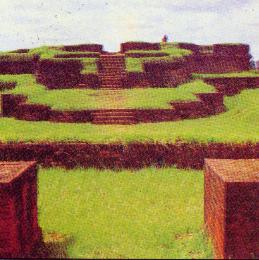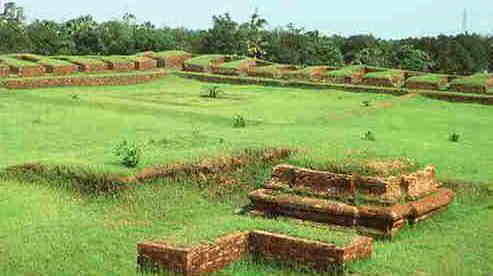History of Bangladesh
Ages of BanglaThe information productivity gap both accelerates and widens. - Michael Dertouzos
The ancient, medieval, and colonial history of Bangladesh covers a period from antiquity to 1947, when India was partitioned. So the history of Bangladesh prior to 1947 is a history of India of which Bangladesh was a part. In fact, the history of India is a history of Bengal for the most part. Today Bangladesh is an independent nation within the Indian subcontinent, but is less than half of the old Bengal or Bangla. The modern state of Bangladesh officially came into existence through a people's liberation war in 1971. Bangladesh is the eastern part of Bangla. Bangladesh (East Bengal) and West Bengal (in India) are the same nation and together they once formed the major part of Bangla (Banga or Gaur). There were some other parts of Bangla though that are no longer within East or West Bangla. Bangla was divided into East and West Bengal by the British, first in 1905, but it proved unpopular and was reversed in 1911. Later during the partition of India, rich Muslim landlords in the East supported the division. So again since 1947, Bangla is divided into at least two parts. Bangla was ultimately ruined by this division and today there are even those who have been so de-culturized that they feel that the people of the other Bangla are foreign! That is the great success of the west. Bangla was one of the most important centres of India and now it is a ruined nation no longer a potential threat to the west. Its long and great history is forgotten by the world and also many Bengals today. Even though Bangladesh is a modern state, her history can be traced back to about 1000 BC. There are many theories about the origin of the name B(v)anga or B(v)angla. Some linguists believe that the name originates from the Tibetan word, "Bans which means wet or moist and Banga (Bengal) is a wet country crisscrossed by a thousand rivers and washed by monsoons and floods from the Himalayas. Some others believe that the name originated from the Bodo (original Asamese in North Eastern India) "Bang La" which means wide plains. Another school suggests the name comes from the name of Prince Vanga. According to legend, Prince Vanga, the son of King Bali and Queen Sudeshna of the Lunar dynasty was the first to colonise Bengal. The name of the original people of Bengal is also taken from legend. One of the tribes emerged from the Indus Civilization after its demise and entered the plains of Bengal while others went elsewhere. They were called the Bong tribe and spoke Dravidian. We know from many ancient Aryan texts of a tribe called B(v)anga that existed in that region.
Muslin FabricThe ancient western reference to the Muslin shows that the legendary fabric is not a new export of Bangla but ancient. It must take its rightful place with cotton and silk fabrics that go back in time in Bangla. The British during their occupation, ended the Muslin production brutally by having the Muslin weavers' thumbs chopped off [see Note below]. The Muslin was legendary because a 50 metre long Muslin fabric could be squeezed into a matchbox. Today's Muslin is a different fabric altogether. The technology is lost.
Ancient ruins of learning centres from an era when Bangla was the centre of Buddhism Source: geocities.com/raqta24/bangladesh2.htm Visit this site for more information Note: It has kindly been brought to my attention by Max Muir that proof of this allegation is difficult to impossible to find. According to Wikipedia's revision history of muslin, the 'thumbs' story appears to be a bit of anti-Company propaganda dating from the Warren Hastings trial and is of dubious veracity. Mr Muir leans toward the following interpretation:
I have a conceptual problem with this. I can see the silkwinders cutting their thumbs - but cutting them off? Somehow, to me, this sounds less believable than the British doing it. If anyone knows a source of proof either way, please contact me. Thanks.
For more articles relating to Money, Politics and Law including globalisation, tax avoidance, consumerism, credit cards, spending, contracts, trust, stocks, fraud, eugenics and more click the
"Up" button below to take you to the page on "How Many Countries in the World?" Clicking "Up" from there will take you to the Index for this section. |
 Animals
Animals Animation
Animation Art of Playing Cards
Art of Playing Cards Drugs
Drugs Education
Education Environment
Environment Flying
Flying History
History Humour
Humour Immigration
Immigration Info/Tech
Info/Tech Intellectual/Entertaining
Intellectual/Entertaining Lifestyles
Lifestyles Men
Men Money/Politics/Law
Money/Politics/Law New Jersey
New Jersey Odds and Oddities
Odds and Oddities Older & Under
Older & Under Photography
Photography Prisons
Prisons Relationships
Relationships Science
Science Social/Cultural
Social/Cultural Terrorism
Terrorism Wellington
Wellington Working
Working Zero Return Investment
Zero Return Investment

